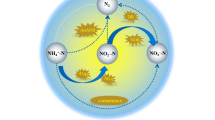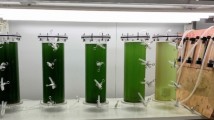Abstract
Methodology was evaluated to selectively enrich hydrogen-producing species present in biological sludge produced during organic wastewater treatment. The influence of bacterial stress enrichment on anaerobic hydrogen-producing microorganisms was investigated in batch tests using serum bottles. Enrichment conditions investigated included application of acute physical and chemical stresses: wet heat, dry heat and desiccation, use of a methanogen inhibitor, freezing and thawing, and chemical acidification with and without preacidification of the sludge at pH 3. For each enrichment sample, cultivation pH value was set at an initial value of 7. After application of selective enrichment (by bacterial stress), hydrogen production was significantly higher than that of untreated original sludge. Hydrogen production from the inocula with bacterial stress enrichment was 1.9–9.8 times greater when compared with control sludge. Chemical acidification using perchloric acid showed the best hydrogen production potential, irrespective of preacidification. Enhancement is due to the selective capture of hydrogen-producing sporeformers, which induces altered anaerobic fermentative metabolism.


Similar content being viewed by others
References
APHA (1992) Standard methods for the examination of water and wastewater, 18th edn. American Public Health Association, Washington, DC
Bahl H, Gottschalk G (1984) Parameters affecting solvent production by Clostridiumacetobutyricum in continuous culture. Biotechnol Bioeng Symp 14:215–223
Benemann JR (1996) Hydrogen biotechnology: progress and prospects. Nat Biotechnol 14:1101–1103
Benemann JR (1998) The technology of biohydrogen. In: Zaborsky OR (ed) Biohydrogen. Plenum, New York pp 19−30
Billings RE (1991) The hydrogen world view. American Academy of Science, Washington, DC
Brock TD, Madigan MT, Martinko JM, Parker J (1994) Biology of microorganisms. Prentice-Hall, New York
Chen CC, Lin CY, Chang JS (2001) Kinetics of hydrogen production with continuous anaerobic cultures utilizing sucrose as the limiting substrate. Appl Microbiol Biotechnol 57:56–64
Chen CC, Lin CY, Lin MC (2002) Acid–base enrichment enhances anaerobic hydrogen production process. Appl Microbiol Biotechnol 58:224–228
Chin HL, Chen ZS, Chou CP (2003) Fedbatch operation using Clostridium acetobutyricum suspension culture as biocatalyst for enhancing H2 production. Biotechnol Prog 19:383–388
Das D, Veziroglu TN (2001) Hydrogen production by biological processes: a survey of literature. Int J Hydrogen Energy 26:13–28
Dunn S (2002) Hydrogen futures: toward a sustainable energy system. Int J Hydrogen Energy 27:235–264
Fang HHP, Zhang T, Liu H (2002) Microbial diversity of a mesophilic hydrogen-producing sludge. Appl Microbiol Biotechnol 58:112–118
Gottschalk G (1986) Bacterial metabolism. Springer, Berlin Heidelberg New York
Harper SR, Pohland FG (1986) Recent developments in hydrogen management during anaerobic biological wastewater treatment. Biotechnol Bioeng 28:585–602
Hart D (1997) Hydrogen power: the commercial future of the ultimate fuel. Financial Times Energy Publishing, London
Henley M, Wallace W, Andrel T (2003) Microbial hydrogen production. AFRL Technol Horiz 3:32–33
Heyndrickx M, De Vos P, Stevens T, De Ley J (1987) Effect of various external factors on the factors on the fermentative production of hydrogen gas from glucose by Clostridiumbutyricum strains in batch culture. Syst Appl Microbiol 9:163–168
Holt JG, Krieg NR, Sneath PHA, Staley JT, Williams ST (1994) Bergey’s manual of determinative bacteriology, 9th edn. Williams and Wilkins, Baltimore, MD
Hyun HH, Zeikus JG, Longin R, Millet J, Ryter A (1983) Ultrastructure and extreme heat resistance of spores from thermophilic Clostridium species. J Bacteriol 156:1332–1337
Ince BK, Ince O (2000) Changes to bacterial community make-up in a two-phase anaerobic digestion system. J Chem Technol Biotechnol 75:500–508
Jean DS, Chang BV, Liao GS, Tsou GW, Lee DJ (2000) Reduction of microbial density level in sewage through pH adjustment and ultrasonic treatment. Water Sci Technol 42:97–102
Jungermann KA, Thauer RK, Leimenstoll G, Deker K (1973) Function of reduced pyridine nucleotide–ferredoxin oxidoreductases in saccharolytic clostridia. Biochim Biophys Acta 305:268–280
Karube I, Urano N, Matsunaga T, Suzuki S (1982) H2 production from glucose by immobilized growing cells of Clostridium butyricum. Eur J Appl Microbiol 16:5–9
Kataoka N, Miya A, Kiriyama K (1997) Studies on hydrogen production by continuous culture system of hydrogen-producing anaerobic bacteria. Water Sci Technol 36:41–47
Kenealy WR, Cao Y, Weimer PJ (1995) Production of caproic acid by cocultures of ruminal cellulolytic bacteria and Clostridium kluveri grown on cellulose and ethanol. Appl Microbiol Biotechnol 44:507–513
Kim BH, Bellows P, Datta R, Zeikus JG (1984) Control of carbon and electron flow in Clostridium acetobutyricum fermentation: utilization of carbon monoxide to inhibit hydrogen production and to enhance butanol yields. Appl Environ Microbiol 48:764–770
Kumar N, Das D (2000) Enhancement of hydrogen production by Enterobacter cloacae IIT-BT 08. Proc Biochem 35:589–593
Kunst A, Draeger B, Ziegenhorn J (1983) UV-methods with hexokinase and glucose-6-phosphate dehydrogenase. In: Bergmeyer HU (ed) Methods of enzymatic analysis, 3rd edn. Metabolites 1: carbohydrates, vol 6. Chemie, Weinheim, pp 163−172
Lamed RJ, Lobos JH, Su TM (1988) Effect of stirring and hydrogen on fermentation products of Clostridium thermocellum. Appl Environ Microbiol 54:1216–1220
Lay JJ (2001) Biohydrogen generation by mesophilic anaerobic fermentation of microcrystalline cellulose. Biotechnol Bioeng 74:280–286
Lay JJ, Li YY, Noike T (1998) A mathematical model for methane production from a landfill bioreactor. J Environ Eng ASCE 124:730–736
Lay JJ, Lee YJ, Noike T (1999) Feasibility of biological hydrogen production from organic fraction of municipal solid waste. Water Res 33:2579–2586
Lee YJ, Miyahara T, Noike T (2002) Effect of pH on microbial hydrogen fermentation. J Chem Technol Biotechnol 77:694–698
Levin D, Pitt L, Love M (2004) Biohydrogen production: prospectus and limitations to practical application. Int J Hydrogen Energy 29:173–185
Liu CL, Peck HD (1981) Comparative bioenergetics of sulfate reduction in Desulfovibrio and Desulfotomaculum sp. J Bacteriol 145:966–973
Lupton FS, Conrad R, Zeikus JG (1984) Physiological function of hydrogen metabolism during growth of sulfidogenic bacteria on organic substrates. J Bacteriol 159:843–849
Minton NP, Clarke DJ (1989) Clostridia—biotechnology handbook, vol 3. Plenum, New York
Mizuno O, Dinsdale R, Hawkes FR, Hawkes DL, Noike T (2000) Enhancement of hydrogen production from glucose by nitrogen gas sparging. Bioresour Technol 73:59–65
Nandi S, Sengupta S (1998) Microbial production of hydrogen: an overview. Crit Rev Microbiol 24:61–84
Oehlert GW (2000) A first course in design and analysis of experiments. Freeman, New York
Ohwaki K, Hungate RE (1977) Hydrogen utilization by clostridia in sewage sludge. Appl Environ Microbiol 33:1270–1274
Okamoto M, Miyahara T, Mizuno O, Noike T (2000) Biological hydrogen potential of materials characteristic of the organic fraction of municipal solid wastes. Water Sci Technol 41:25–32
Olson JC, Nottingham PM (1980) Temperature. In: Silliker JH, Elliott RP, Baird-Parker AC, Bryan FL, Christian JHB, Clark DS, Olson JC, Roberts TA (eds) Microbial ecology of foods: factors affecting life and death of microorganisms. Academic, New York pp 1–37
Postgate JR (1965) Recent advances in the study of the sulfate-reducing bacteria. Bacteriol Rev 29:425–441
Reimann A, Biebl H, Deckwer WD (1996) Influence of iron, phosphate and methyl viologen on glycerol fermentation of Clostridiumbutyricum. Appl Microbiol Biotechnol 45:47–50
Setlow P (2000) Resistance of bacterial spores. In: Storz G, Hengge-Aronis R (eds) Bacterial stress responses. ASM Press, Washington, DC, pp 217–230
Sonenshein (2000) Bacterial sporulation: a response to environmental signals. In: Storz G, Hengge-Aronis R (eds) Bacterial stress responses. ASM Press, Washington, DC pp 199–215
Sparling R, Risbey D, Poggi-Varaldo HM (1997) Hydrogen production from inhibited anaerobic composters. Int J Hydrogen Energy 22:563–566
Speece RE (1996) Anaerobic biotechnology for industrial wastewaters. Archae Press, Nashville, TN
Suzuki S, Karube I (1983) Energy production with immobilized cells. Appl Biochem Bioeng 4:281–310
Sylvia DM, Fuhrmann JJ, Hartel PG, Zuberer DA (1999) Principles and applications of soil microbiology. Prentice-Hall, Englewood Cliffs, NJ
Taguchi F, Mizukami N, Taki TS, Hasegawa K (1995) Hydrogen production from continuous fermentation of xylose during growth of Clostridium sp. strain no-2. Can J Microbiol 41:536–540
Takabatake H, Suzuki K, Ko I-B, Noike T (2004) Characteristics of anaerobic ammonia removal by a mixed culture of hydrogen producing photosynthetic bacteria. Bioresour Technol 95:151–158
Tanisho S, Kamiya N, Wako N (1989) Hydrogen evolution of Enterobacter aerogens depending on culture pH: mechanism of hydrogen evolution from NADH by means of membrane-bound hydrogenase. Biochim Biophys Acta 973:1–6
Thauer RK, Jungermann KA, Decker K (1977) Energy conservation in chemotrophic anaerobic bacteria. Bacteriol Rev 41:100–180
Ueno Y, Haruta S, Ishii M, Igarashi Y (2001) Microbial community in anaerobic hydrogen-producing microflora enriched from sludge compost. Appl Microbiol Biotechnol 57:555–562
US DOE Website (2005a) http://www.eere.energy.gov/hydrogenandfuelcells/faqs_hydrogen.html
US DOE Website (2005b) http://www.eere.energy.gov/hydrogenandfuelcells/production/basics.html
Van Ginkel S, Sung S, Lay JJ (2001) Biohydrogen production as a function of pH and substrate concentration. Environ Sci Technol 35:4726–4730
Walther R, Hippe H, Gottschalk G (1977) Citrate, a specific substrate for the isolation of Clostridium sphenoides. Appl Environ Microbiol 33:955–962
Wang CC, Chang CW, Chu CP, Lee DJ, Chang BV (2003a) Sequential production of hydrogen and methane from wastewater sludge using anaerobic fermentation. J Chin Inst Chem Eng 34:683–687
Wang CC, Chang CW, Chu CP, Lee DJ, Chang BV, Liao CS (2003b) Producing hydrogen from wastewater sludge by Clostridium bifermentans. J Biotechnol 102:83–92
Zajic JE, Kosaric N, Brosseau JD (1978) Microbial production of hydrogen. Adv Biochem Eng/Biotechnol 7:57–109
Zehnder AJB (1988) Biology of anaerobic microorganism. Wiley, New York
Zehnder AJB, Huser BA, Brock TD, Wuhrmann K (1980) Characterization of an acetate decarboxylating, non-hydrogen-oxidizing methane bacterium. Arch Microbiol 124:1–11
Zinder SH, Anguish T, Cardwell SC (1984) Selective inhibition by 2-bromoethanesulfonate of methanogenesis from acetate in a thermophilic anaerobic digester. Appl Environ Microbiol 47:1343–1345
Acknowledgements
This research was supported in part by the Utah Agricultural Experiment Station, Utah State University, Logan, Utah 84322-4810, JP No. 7682.
Author information
Authors and Affiliations
Corresponding author
Rights and permissions
About this article
Cite this article
Cheong, DY., Hansen, C.L. Bacterial stress enrichment enhances anaerobic hydrogen production in cattle manure sludge. Appl Microbiol Biotechnol 72, 635–643 (2006). https://doi.org/10.1007/s00253-006-0313-x
Received:
Revised:
Accepted:
Published:
Issue Date:
DOI: https://doi.org/10.1007/s00253-006-0313-x




